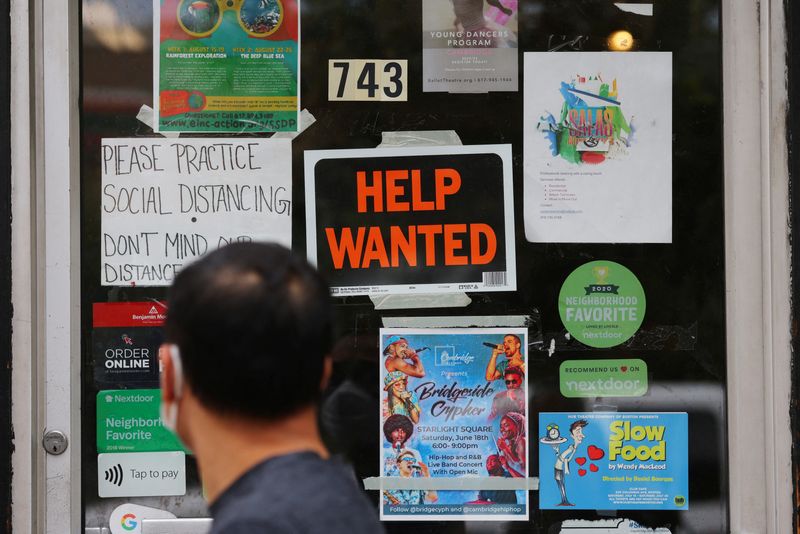By Lucia Mutikani
WASHINGTON (Reuters) - U.S. job openings increased solidly in October while layoffs dropped by the most in 1-1/2 years, suggesting the labor market continued to slow in an orderly fashion.
But the Job Openings and Labor Turnover Survey, or JOLTS report, from the Labor Department on Tuesday also showed employers hesitant to hire more workers. The historically low level of layoffs is anchoring the labor market and the broader economy through higher wages that are driving consumer spending.
There were 1.11 job openings for every unemployed person in October, up from 1.08 in September. This ratio, which peaked at 2.03 in early 2022, is now below the 1.2 that prevailed before the COVID-19 pandemic.
Workers also grew more confident in the labor market, with resignations posting their largest increase in nearly 1-1/2 years. The state of the labor market could determine whether the Federal Reserve delivers a third consecutive interest rate cut this month amid lack of progress in lowering inflation back to the U.S. central bank's 2% target.
"The report points to ongoing resilience and doesn't flag major concerns about the economy," said Oren Klachkin, financial market economist at Nationwide. "With policy still restrictive in its view, the Fed can probably push through with another rate cut before considering a pause next year."
Job openings, a measure of labor demand, had risen by 372,000 to 7.744 million by the last day of October, the Labor Department's Bureau of Labor Statistics said. Data for September was revised lower to show 7.372 million unfilled positions instead of the previously reported 7.443 million.
Economists polled by Reuters had forecast 7.475 million vacancies.
The increase in job openings was led by the professional and business services sector, with 209,000 unfilled positions. Vacancies rose by 162,000 in the accommodation and food services industry and climbed by 87,000 in the information sector.
But there were 26,000 fewer open positions in the federal government. The job openings rate increased to 4.6% from 4.4% in September. The U.S. South accounted for most of the job openings after a sharp decline in September, which economists had attributed to the impact of Hurricane Helene.
All the unfilled positions were in small businesses, with 321,000 vacancies at establishments employing one to nine people.
Hires fell by 269,000 to 5.313 million, pulled down by declines in construction, manufacturing, finance and insurance, professional and business services as well as the leisure and hospitality industry. The hires rate dropped to 3.3% from 3.5% in September.
Hiring declined across all business sizes. It fell in all four regions, with the South recording a drop of 106,000, likely because of Helene and Hurricane Milton.
"While concerning on the surface, some of the slowing in hiring may be the result of hurricane disruptions, as employers may have been keeping openings up but pushing back interviews or start dates to deal with the fallout from Helene and Milton," said Cory Stahle, an economist at Indeed Hiring Lab.
Stocks on Wall Street were mixed. The dollar fell against a basket of currencies. Yields on longer-dated U.S. Treasuries rose.
MORE WORKERS QUITTING
Higher borrowing costs as the Fed battled inflation have left businesses with little appetite to increase headcounts. Financial markets saw a roughly 72% chance of a 25-basis-point rate cut at the Fed's Dec. 17-18 policy meeting, CME Group's (NASDAQ:CME) FedWatch tool showed.
The central bank kicked off its policy easing cycle in September and has reduced its policy rate by 75 basis points to the 4.50%-4.75% range, having hiked it by 5.25 percentage points in 2022 and 2023.
Nonetheless, employers are not cutting their workforces on a large scale. Layoffs decreased by 169,000 in October, the largest drop since April 2023, to 1.633 million. There were fewer job cuts in the construction, manufacturing, leisure and hospitality industries. But layoffs increased by 60,000 in the retail sector. The layoffs rate fell to 1.0% from 1.1% in September.
More workers quit their jobs, likely in search of greener pastures. Quits surged by 228,000, the most since May 2023, to 3.326 million. The quits rate, viewed as a good measure of labor market confidence increased to 2.1% from 1.9% in September.
The higher quits rate, which suggests a gradual slowdown in wage growth, was consistent with a recent jump in consumer confidence.
The hurricanes and strikes distorted the labor market in October. With rebuilding underway in the areas devastated by the storms and the strikes at Boeing (NYSE:BA) and another aerospace company having ended, a sharp acceleration in job growth is anticipated in November.
A Reuters survey of economists estimated payrolls increased by 200,000 jobs last month after rising by only 12,000 in October, the fewest since December 2020. The unemployment rate is forecast to tick up to 4.2% from 4.1% in October.

The closely watched employment report for November is due to be released on Friday.
"But the difference between hires and separations lends downside risk to our forecast for a sizeable rebound in November nonfarm employment," said Matthew Martin, a senior U.S. economist at Oxford Economics.